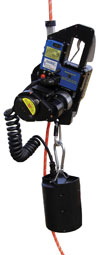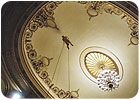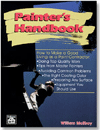
I am an avowed child of the ‘50s. I grew up on the boomer tales of Superman on the little screen. Every 10-year-old kid in my neighborhood dreamt of “leaping tall buildings in a single bound.” Now 50 years later, the hippest among us carry Dick Tracy video communicators. Even as you read this article, we’re refining the personal commuter version of the “jet pack”, assembling the international space station and shuttling weightless tourists into space. Certainly to our grandparents, nothing imaginable is really impossible. Most recently, I have discovered a totally unique device capable of transporting one (or even two) people up or down to remote elevations at the rate of 1 foot per second with less effort than sitting down in your favorite chair and turning on the TV. It might not be in a “single bound”, but it’s darn close.
THE LATEST TECHNOLOGY
Originally developed for the Special Forces by Quoin International, Inc. (founded in 1990) a civilian version of the PowerQuick powered ascender unit is now being manufactured by Bonanza Products, Inc., under an exclusive license. In 2005 it was redesigned for fire-rescue service and telecommunication/construction industries and any personnel who formerly had to struggle to make high-angle rope hand/foot access to a mere 100-foot elevation. One of the distributors/trainers for the PowerQuick is Apex, Inc., in Greensburg, Pa., with Mr. Tom Early at the helm. His extensive aerial tower work within the communication industry has given him excellent insight and preparation for developing a future course for PowerQuick. “While working at heights has inherently unsafe aspects, PowerQuick was developed with safety as its paramount feature,” he said.Another PowerQuick distributor/trainer is Mark Dennington, a fourth-generation union ironworker for 25 years and creator of the outstanding safety harness which bears his name, which in turn is produced by Dennington Safety Gear in Shrevesport, La. “The PQ is the ultimate confined space rescue and emergency extraction unit on the market today with the highest safety features in mind,” Dennington said. As those who climb to heights for a living quickly realize, this product will change their methods and reduce their risks significantly.
As an aging, technical rope-rescue instructor, I can attest that, “jugging” or “frogging” up a rescue line with all of your gear using hand-ascenders in the July sun or January wind can be a brutal, physical and mental exercise. Even under the best conditions, a well-trained, equipped and conditioned rescuer will typically arrive at the point of operation in a seriously diminished physical and mental capacity and ready for serious rehydration and a lactic acid “shake-out.” The safety of the high-angle rope operation at that point may be demonstrably limited or seriously jeopardized. Now with two weight-classified models (PQ 300-1/136 kg and PQ 500-1/227 kg), the PowerQuick ascender can quickly (and effortlessly) elevate one or two people to many hundreds of feet at an amazing 0.7 to 1.0 feet per second. Attached to the bosun’s seat, incorporated in the latest technology Dennington full-body rescue or tower worker’s harness, one merely holds on to the palm-interlock switch and enjoys the ride. Unlike a winding-drum hoist which wraps the ascent line around a capstan, the principle of a PowerQuick is based on a traction-hoist, which climbs a stationary-anchored 1/2-inch (11 mm) static kernmantle rope, by running it through a series of drive and idler sheaves. Vertical and speed control is as simple as flipping a thumb control and turning a grip on the stabilizer handle to adjust the traction rate. And a remote control pad allows operation without being near the device.

PRACTICAL USES
There are so many practical uses being discovered for this device that I am reluctant to suggest an outer limit. Clients have purchased the PowerQuick for use in such environments as masts and towers, chimneys, high-rise buildings, bridges, oil derricks, drilling platforms, and cliffs and shafts. There is basically no occupation requiring work at elevations that cannot find some application for it. Safe mobilization and demobilization of the unit by trained personnel takes only minutes, saving ever-increasing labor costs. Unlike a suspended scaffold unit, it’s personal use creates a low impact for hazardous exposure to nearby pedestrians or coworkers and eliminates the need for heavy ascent planning.SAFETY FEATURES
Built to military specifications, it is powered by a 36vdc/30 amp Nickel-Metal Halide (NiMH) rechargeable battery capable of ascending 5-600 feet per charge (800 charge cycles depending on ambient temperatures). The unit’s charger signals with a green LED when the charge is complete. The battery accounts for approximately half of the unit’s total weight of 28 pounds. Both models are designed with many excellent redundant safety features including: A palm interlock for pre-start; an auto-brake in hands-off position providing emergency lock-off; an Emergency Stop Button; “low power” descent capability; rope security in drive mechanism when under load. It is designed for ergonomically comfortable overhead use with no pinch points or sharp edges. While the PQ 500 has a static load maximum capacity of 1,100 pounds and dynamic capacity of 2,000 pounds, a built-in load limiter prevents lifting a load in excess of 600 pounds. Manufacturer’s recertification is recommended whenever the unit has been on-line dropped more than 1 foot. An odometer is located on the outside of the unit in plain view, to maintain a record of the ascent footage during all operations. The operator cannot be stranded due to battery failure. If power is lost for any reason during a climb it can be switched to “descend” mode, as it uses so little power on descent. It also has a manual descent mode capability.The housing cover is released by a safety latch and swings wide to reveal the rope traction mechanism (capstan) inside. Once the rope is properly threaded in the unit, the lower line is pulled taut in order to properly seat it. The D ring of the seat harness is then attached to the mounting ring on the Ascender. The operator then mounts a trailing rope grab to a second, well-anchored belay line for fall protection. The integral 5-foot lanyard on the Dennington Ascender Harness is connected to the rope grab to complete a redundant personal fall arrest system. According to Mark Dennington, “The unique technological features of the Dennington Harness and the PowerQuick combine to create the best and safest powered ascender in the world today.”
OPERATOR TRAINING
Comprehensive training of all operators by a manufacturer’s authorized Competent Person (CP) instructor is required before operating any PQ unit. Of course, a mandatory “hands-on” field evaluation, under typical working conditions, is strongly recommended for each employee with a potential to use a PQ.EQUIPMENT INSPECTION
According to OSHA’s single point adjustable suspension scaffold regulations (1926.452(o)) all components of all equipment shall be pre-shift, pre-use and regularly inspected by a Competent Person for any defects or damages. Critical inspections are also required whenever anything has occurred during its operation which may have “affected its structural integrity,” such as a drop over a distance of four feet onto a hard surface or a shock load suspected in excess of 1,200 pounds. Whenever in doubt, the unit manufacturer’s re-certification is mandated.Anyone whose occupation depends on ropes for suspension understands the principles of rope management and the need for a clean rope in the condition in which it was manufactured. Unlike a winding drum hoist, which tends to wear ropes primarily near stop/start drum contact points, the drive sheaves of a traction hoist may potentially wear out the entire travel length of the line. While the outside sheathing of a kernmantle rope is often the first to show abrasion and wear, keep in mind that the core of the rope is also capable of distention and failure before the sheathing. Use the hands to inspect the diameter for any wide points of “fiber bunching” or thin points of elongation. When in doubt, always replace ropes immediately with new and destroy the old by cutting up or incinerating them.
While simple to use, this is a complex motorized device designed to professional standards. Its use should always be closely monitored. Employers should designate a Competent Person in writing in their corporate Safety and Health Program for managing any mono-point suspended scaffolding, such as the PowerQuick. The principle of “When in doubt, tag it out” is imperative. All PQ operators will be trained and evaluated by the CP to tag a unit “Out-of-Service,” based on the manufacturer’s safe-for-operation criteria. Ascenders will remain tagged-out until the CP for suspended scaffolds either adjusts the unit (within limitations), provides another certified unit or places it back into service with a detailed, yet comprehensive, explanation of why it is not considered “Out-of-Service.”
The flexibility of the PowerQuick on a tall wall or ceiling project is easily demonstrated by its remote control function. The design of the PowerQuick is for personal ascending and for lifting tools and equipment. A compliant personal fall arrest system should always be included in the use of the PQ by competently trained operators.
CONCLUSION
This PowerQuick Personal Ascender is a superb solution to the difficult, site-specific problems unique to vertical access. I consider the superb workmanship and engineering that went into its manufacture absolutely “aircraft quality.” While there may be many new applications discovered for this device, it is not meant for everyone who needs to gain sub or super-access to an elevated location. While a pair of hand-powered ascenders with ‘binaries and boot straps by Petzl or CMC may only run up a $200 + invoice, the PowerQuick may net $5,800, with extra batteries. The Dennington Rescue Harness and other miscellaneous climbing accessories further increase the cost. This is a professional piece of equipment for the serious professional. When one considers its daily use in difficult aerial maneuvers, however, its cost is hardly a decisive factor. The fact that the most difficult ascents and descents are made quickly, easily and safely is the only criteria worth debating.The PowerQuick represents a quantum leap forward for the high and low-angle technical rope access community. From this day forward, the technology of high-angle rope access and rescue has reached a course-change point, forever altering both the mental culture and physical behavior of aerial rope work. Now everyone may reach extreme elevations and be rescued “safely and promptly” without the equipment delays, physical fatigue or mental stress most commonly encountered by professionals in the past. Until “anti-gravity boots” hit the market, this will be the best method of rope access that technology has to offer, guarantee

Sidebar: One Contractor's Experience
Theater ceiling project was easy with Power AscenderPrize Construction, a local commercial restoration contractor in nearby Scotia, N.Y., was looking for a rope access device which would enable workers to easily and efficiently ascend 60 feet in order to repair the grand domed ceiling of the historic Proctor Theatre in Schenectady. While 60 feet was certainly within the reach of a standard, supported scaffold system, the seating plan, sloped floor and entertainment schedule of such a popular theatre all but eliminated its practical use.
Schenectady native Ed Zemeck, president of Prize Construction, has been a long-time fan and supporter of Proctor Theatre. While attending a performance of “The Phantom of the Opera” with his wife, Ed noticed obvious areas of ceiling disrepair in an otherwise renovated project. He contacted the theatre’s owner and suggested he could easily repair the damaged ceiling. In a matter of days he purchased his first PowerQuick Ascender from Cathryn Jacobson, CEO of Conanza Products. After just one morning of training, he was amazed at the intuitive ease with which his workers became comfortable with it’s operation. Before long, according to Ed, they were confidently accessing the ceiling as if they’d been doing it for years. They utilized pre-existing sleeved holes installed in the ceiling to rig their 12 mm static kernmantle lines from ample structural steel in the access above the ceiling. While the radius of the elevated work area was clearly limited to the worker’s reach, there were plenty of these sleeved points available. All the while work was being done, the theatre casts were performing rehearsals without interruption. The set up and dismantling of welded end frame scaffolding would have been a major distraction and consumed much valuable time before the show’s opening date.



Report Abusive Comment